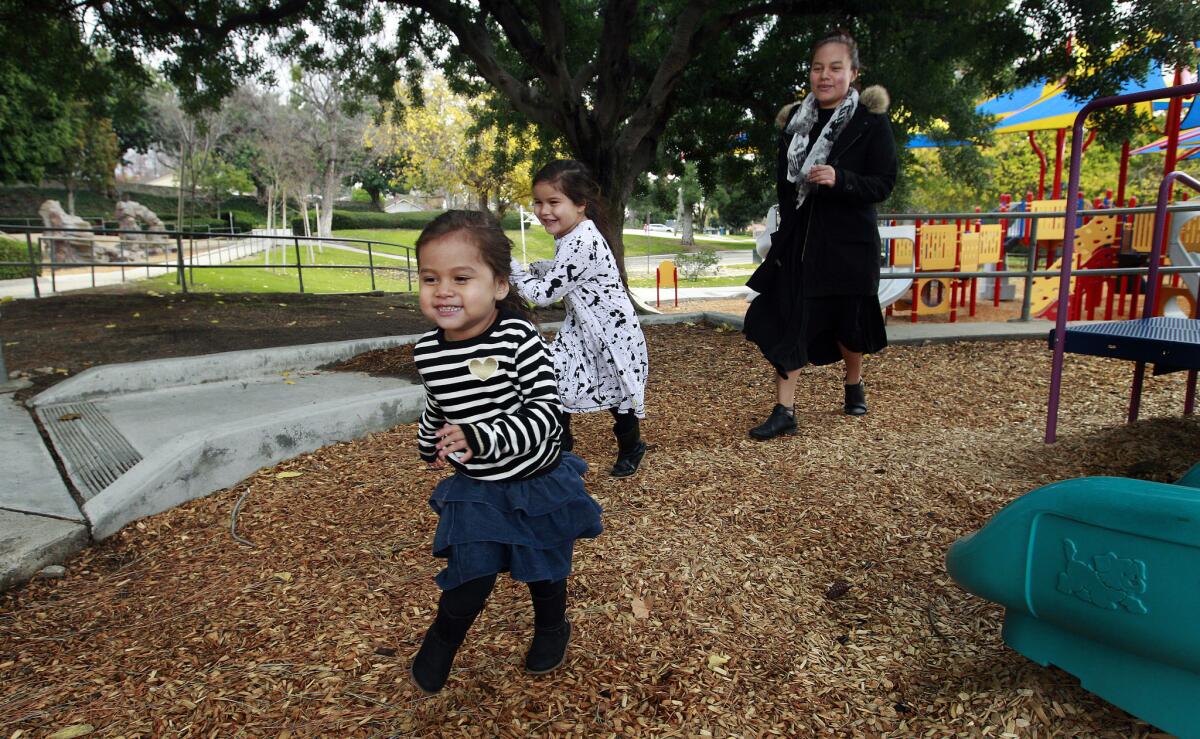For some workers, pay raise comes with loss of cheap child care

May Martinez is losing access to subsidies provided by the state to cover child care, because her husband got a raise. Mel Melcon / Los Angeles Times
- Share via
When the minimum wage in California rose to $10.50 an hour Jan. 1, more than a million people got a raise. But for an untold number of families across the state, that pay bump could price them out of child care.
This year, for the first time, two parents working full time at minimum-wage jobs, with one child, will be considered too well off to qualify for state subsidies for day care and preschool. It’s been 10 years since the state set the threshold for who is poor enough to get the benefit, which is pegged to 2005 income levels.
“It’s an unintended consequence that was never part of the plan,” says Rich Winefield, the former executive director of Bananas, a day-care and preschool referral agency in Oakland. “It’s unbelievable that we have policy that creates this.”
That’s just one of the likely ripple effects a rising wage will have for California businesses, their employees and their customers. Most of the minimum-wage debate nationwide has focused on rising worker incomes and possible job loss as employers adjust to higher costs. But votes to gradually increase the minimum wage to $12 or $15 in several states could also affect parents’ access to child-care benefits.
In one sense, increasing the minimum wage is unambiguously good: It gives the poorest workers in the country a raise after decades of stagnant pay. And a rising wage floor will also lead employers to bump up wages for experienced employees who earn slightly more than the minimum to preserve the hierarchy.
The economy is a complex machine, though, and what seems like a straightforward tool to make people richer can force them to make wrenching choices.
California gives the poorest parents in the state a discount on their day-care and preschool expenses, which came to hundreds of dollars a month for parents of 403,561 kids last school year.
But the state has not raised the income limit to qualify for child-care subsidies since 2007, when it determined that to get the discount, a family of three had to make $42,216 or less, which was 70% of the state’s median income in 2005. The income limit rises for larger families.
Two people making the current minimum wage in the state and working 40 hours a week earn $43,680.

For years, parents have been turning down promotions and raises at work so that they can keep their benefit, say advocates and child-care professionals.
Until October, May Martinez and her husband were taking in less than the income limit on his salary as a security guard at CBS Studios. Martinez, 27, is studying toward a bachelor’s degree and got a subsidy from the state to put her 4-year-old and 2-year-old in day care in Santa Clarita while she was in class.
Then Martinez’s husband got a promotion, and a $4-an-hour raise. She was thrilled — until she told her kids’ day-care center the news.
The Center for Early Childhood Education, at the College of the Canyons in Santa Clarita, notified Martinez that the raise would put the couple over the income threshold that the state set for child-care subsidies.
Instead of paying $167 each month to the center for half-day care, Martinez would be charged the market rate of $2,400.
After paying for rent, utilities and food, the new day-care costs would outweigh the new income from Martinez’s husband’s promotion. “By a longshot, we would be in the hole,” Martinez said.
At first, Martinez’s husband tried to turn down the pay bump, begging his supervisors to give him the promotion without the raise. No dice. The couple had serious conversations about turning down the new job altogether, but neither wanted to risk angering his bosses.
Martinez eventually decided that this year, she will move to a part-time schedule at La Verne College, and take night and online courses, so that she can take care of her children during the day.
“It is an injustice,” Martinez said, adding that now she has no idea when she’ll be able to finish her degree and start working. “It’s going to be delayed completely.”
Six hundred miles away, in Humboldt, Alicia Combs is in a similar panic.
Combs was homeless six years ago, bouncing around on friends’ couches, but started to remake her life after she had her first son in 2010. She got a job as an office assistant in Eureka, eventually had another son, and put both in day care thanks to a state subsidy.
Then, in September, the single mom was given an automatic raise of less than a dollar. That put her wage at $21.21 an hour, which meant she would earn about $160 more than the monthly income limit for her family of three.
She pays around $360 to send both kids to day care with the help of the benefit. Now, she will have to pay close to $1,000 a month, which she says she can’t afford.
“I worked really hard to get where I am at, and if I lose the child-care subsidy I am not sure what I’ll do,” Comb said.
As the minimum wage heads to $15, more and more parents stand to be in a similar squeeze, since they can’t turn down the mandated raise.
“Many legislators, probably including the governor, did not realize the impact the minimum wage would have on the cost of providing child care,” said Kim Kruckel, the executive director of the Child Care Law Center, a legal advocacy nonprofit in San Francisco.
In August, the state Senate Appropriations Committee held back a bill that would have updated the criteria for child-care subsidies to use the current state median income because of concerns that it would be too expensive. The Department of Finance estimated that raising the threshold would lead to costs “in the low tens of millions.”
H.D. Palmer, a spokesman for the Department of Finance, noted in an email that “since 2013, California has invested $742 million in subsidized child care and early learning programs.” He said that despite the minimum-wage increase, the majority of families receiving subsides would stay in the program in 2017.
The state will spend $3 billion on child care and preschool programs this fiscal year, which nearly brings funding levels back to where they were before the recession.
In December, Assembly members Miguel Santiago (D-Los Angeles) and Lorena Gonzalez (D-San Diego) introduced a new bill that would increase the subsidy income limit.
Child-care advocates say their best hope for updating the threshold is through the debates over next year’s budget, which will begin after Gov. Jerry Brown proposes his version of the budget next week.
Parent representatives and child-care providers plan to lobby the budget committees of the Assembly and the Senate in coming months to demand that Brown increase the limit in the final iteration of the budget, which will pass in June.
Brown himself could propose raising the limit, but advocates aren’t holding their breath.
“He has not up to this point shown a tremendous interest in improving funding or quality for child care,” said Winefield, the former child-care executive.
Child-care providers, meanwhile, have their own concerns over rising wages.
Lisa Wilkin, who runs 10 child-care centers across Los Angeles, says she’s run out of places to cut costs. The executive director of the Child Care Consortium reluctantly cut two administrative positions last year and is set to release five more teacher assistants this year to adjust to rising pay.
But there’s only so much whittling she can do; California mandates that child-care centers employ one adult for every four infants they take in.
“If you have one less person working a shift at a restaurant maybe the service is slower, but if you have one less person in child care you are breaking the law,” Wilkin said. She used to cover 100% of employees’ health, dental and life insurance, but this year she is considering asking them to chip in.
“It is a low-wage industry. I desperately want to pay my teachers more money,” Wilkin said. But she said she can’t charge much more than she already does, because the state limits the amount that centers get to look after the children of low-income parents.
This year, centers will get a standard rate of $875 a month for full-time preschool for each child with a subsidy. Some of that cost is paid by the state, and some is paid by parents, depending on their income.
In reality, the cost to child-care providers for offering a month of full day preschool ranges from $800 to $1,500, depending on the area.
The minimum wage bumped up pay for entry level workers at Wilkin’s centers, but she hasn’t been able to boost more experienced teachers’ salaries by much.
If child-care providers have to keep cutting benefits and compressing their pay scale, they may find it hard to keep workers, said Kristin Schumacher, an analyst at the nonprofit California Budget & Policy Center.
“Why would you care for children all day when you can make more working for Costco?” Schumacher said.
Follow me @NatalieKitro on Twitter
ALSO
When telling the truth is actually dishonest
U.S. economy creates a modest 156,000 jobs in December
Americans don’t want to scrap Obamacare without something to replace it, new poll shows
More to Read
Inside the business of entertainment
The Wide Shot brings you news, analysis and insights on everything from streaming wars to production — and what it all means for the future.
You may occasionally receive promotional content from the Los Angeles Times.











